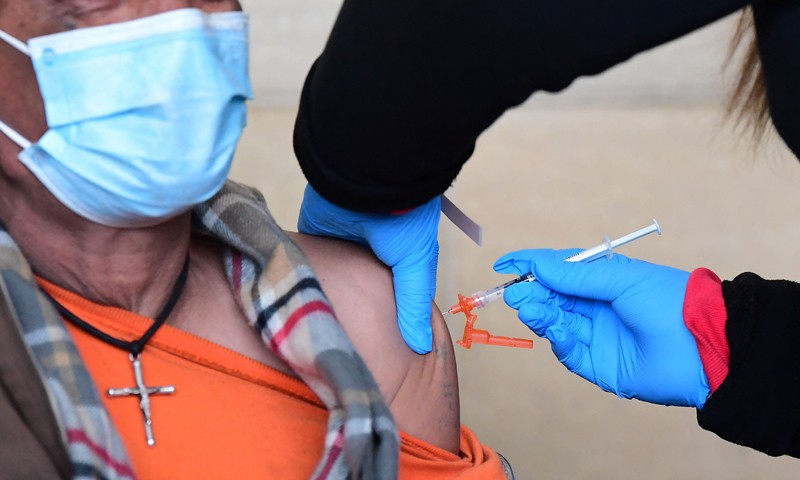Individuals who change into contaminated with the Omicron variant are much less more likely to unfold the virus to others if they’ve been vaccinated or have had a previous SARS-CoV-2 an infection, based on a examine in US prisons1. And individuals who have had a previous an infection and been vaccinated are even much less more likely to cross on the virus, though the advantage of vaccines in lowering infectiousness appears to wane over time.
The findings are excellent news, says Megan Steain, a virologist on the College of Sydney, Australia. They present that the extra publicity folks must the virus, whether or not via vaccines, boosters or infections, the “larger the wall of immunity”, she says. “If we are able to hold excessive ranges of booster vaccinations up, then we are able to lower how infectious individuals are after they’re sick,” says Steain.
The examine was posted as a preprint on medRxiv this month and has not been peer reviewed.
Omicron wave
Nathan Lo, an infectious-disease researcher on the College of California, San Francisco, and colleagues analysed information on greater than 22,000 confirmed instances of SARS-CoV-2 an infection throughout California’s 35 grownup prisons over a 5-month interval beginning on the finish of 2021, when the primary wave of Omicron started ripping via the US. The wave began with the BA.1 subvariant, however by the top of April, BA.2 had overtaken it and was the most typical reason behind COVID-19 within the nation. Earlier research have recommended that vaccinated individuals are much less more likely to unfold the virus in the event that they had been subsequently contaminated with Delta, however Lo’s examine is among the first to think about whether or not vaccines and prior an infection cut back infectiousness with Omicron.
The crew discovered that amongst people with COVID-19, those that obtained at the very least one vaccine shot had been 24% much less more likely to infect shut contacts— on this case cellmates — in contrast with unvaccinated prisoners. Individuals who had been contaminated earlier than had been 21% much less more likely to infect others in contrast with prisoners with no prior an infection, and those that had been each vaccinated and beforehand contaminated had been 41% much less more likely to cross on the virus in contrast with unvaccinated people with out a earlier an infection.
Lo says he’s stunned on the dose–response relationships; every vaccine dose an individual has had diminished the danger of passing on the virus by an additional 12%, on common. How not too long ago folks had been vaccinated was additionally vital. For each 5 weeks that handed since an individual’s final vaccine dose, the danger of transmitting the an infection to a detailed contact elevated by 6%.
New infections
Though vaccination and prior an infection assist to cut back Omicron’s infectiousness, neither had been sufficient to halt the variety of new infections amongst prisoners. 4 occasions out of 5, the individuals who unfold on the virus to others had been vaccinated or beforehand contaminated.
Prisoners had been remoted after they examined optimistic, however shut contacts had normally been uncovered for round 2 days earlier than the COVID-positive particular person was remoted, says Lo. Unvaccinated folks had a 36% probability of transmitting the virus to shut contacts however prisoners who had been vaccinated and had a previous an infection nonetheless had a 20% threat of spreading the an infection.
Subsequent variant
Steain says the findings accord with what researchers know concerning the virus up to now. However as new variants evolve, it’s attainable that the way in which they trigger infections might change. “If some variants are in a position to replicate sooner, for instance, then they is likely to be extra infectious since you’re getting larger viral masses, sooner, within the nasal cavity, and due to this fact, you’ll suppose that might equate to extra shedding,” says Steain.
Earlier research on transmissibility have typically centered on households, the place transmission is much less more likely to happen than in cramped jail cells. And virtually all of these research had been performed earlier than Omicron, typically in individuals who both weren’t vaccinated or had solely the primary set of vaccines.
Allen Cheng, an infectious-disease doctor and epidemiologist at Monash College in Melbourne, Australia, is keen to see whether or not the findings from the jail examine are replicated in family research, which could higher replicate how the virus spreads locally. If replicated, the findings will most likely apply to different rising variants, too, given that almost all are subvariants of Omicron, he says.
And, though the advantages of vaccination in lowering transmission fade over time, he welcomes the information that prior an infection might cut back transmission in a future an infection. “Notably with Omicron, the place we’re having a lot bother attempting to manage it generally, we’re proud of something we are able to get,” says Cheng.


